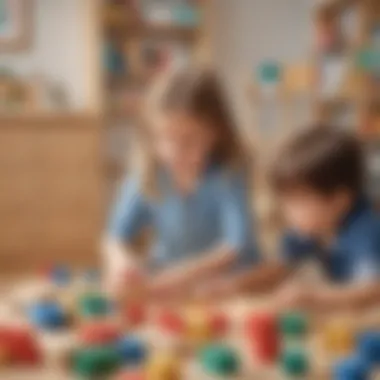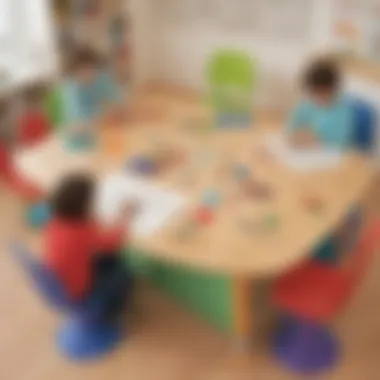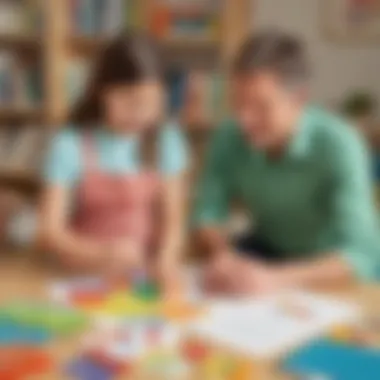The Role of Shape Practice in Child Development


Intro
In the realm of early childhood education, recognizing shapes plays a crucial role in various aspects of development. Cognitive growth, physical coordination, and social interaction are all enhanced through shape practice. For young learners, engaging with shapes is not just about memorization but also developing problem-solving skills and spatial awareness. In turn, these skills foster a foundation for later academic performance. Understanding the central role that shapes pan in child development entails a closer look at effective strategies and enjoyable activities.
Additionally, incorporating shape recognition in everyday situations can provide immense benefits. Shape practice becomes invaluable when woven into daily routines. Caregivers, be it parents or educators, are in unique positions to guide children through this process. They can make shape learning enjoyable, emphasizing the cognitive, physical, and social benefits of these activities.
Fun Activities Ideas
Engaging children through fun activities is vital for enhancing their grasp of shapes. Here, we will delve into various contexts to support shape practice, offering a wide array of ideas.
Indoor Activities
Indoor activities allow for creativity while offering structured learning opportunities. Here are a few suggestions:
- Shape Sorting: Use various objects for children to sort by shape. This can include toys, blocks, or household items.
- Shape Drawing: Provide paper and colored pencils for kids to draw and identify shapes. This creates a visual experience that reinforces understanding.
- Shape Scavenger Hunt: Hide shape-related items around the house and have children find them, teaching them how to recognize shapes in their environment.
Outdoor Adventures
The outdoors presents unique opportunities to explore shapes in larger contexts:
- Nature Walks: During walks, ask children to spot shapes in trees, flowers, or cloud formations. This activity enhances observational skills.
- Shape Playground Games: Encourage games that involve running between marked shapes, integrating physical activity with learning shapes.
- Outdoor Art: Use sidewalk chalk to create shapes on the pavement, allowing children to jump from shape to shape, merging movement with visual knowledge.
Arts and Crafts
Arts and crafts bring a tactile component to shape learning:
- Shape Collages: Provide cut-outs of different shapes, allowing children to create their collages and discuss the colors and forms.
- 3D Shape Building: Utilizing modeling clay or play-dough lets kids mold different shapes and engage in imaginative play.
- Pattern Crafts: Use various shapes to form recurring patterns, demonstrating how shapes connect interactively in art.
Science Experiments
Introducing shape concepts through science can deepen their learning:
- BubbleFormation: Experimenting with soap bubbles highlights the concept of shape, as bubbles form in perfect spheres naturally.
- Shadow Play: Use a flashlight to study how shapes cast shadows, helping children link light and form in a hands-on manner.
- Geometry in Nature: Investigate geometric shapes found within natural structures, such as flower petals and leaves, planting inquisitive thinking of forms.
Cooking and Baking
Cooking provides fun methods to incorporate shapes into activity:
- Anatomy of Shapes in Food: Use cookie cutters to create different shapes during baking.
- Shape Recognition during Meal Prep: Encourage children to cut fruits and vegetables into their favorite shapes, introducing them to culinary arts along with shape learning.
- Pasta Shapes: Engage kids by discussing and identifying different pasta shapes while preparing meals, reinforcing the concept through edible experiences.
Engaging in varied activities revolving around shapes enriches children's learning journey, offering different outcomes from cognitive to physical advancements.
Understanding Shape Practice
Shape practice plays a bhe crucial role in child development. It is not just about recognizing different forms, but rather it affects a child’s cognitive, physical, and social well-being. This section delineates the importance of shape practice and lays the foundational issue for what will be discussed further.
Definition and Relevance
Shape practice can be defined as the engagement of children in activities that recognize, categorize, and manipulate various shapes. This practice is relevant because it aligns with the natural inclination of children to explore their environment. As children navigate through form and space, they develop skills that allows them to make sense of the world around them. Shape recognition enhances their spatial awareness and paves the way for mathematical understanding, ultimately reflecting its importance in pre-K and primary education.
The Cognitive Benefits of Shape Practice
Cognitive development is foundational during early childhood. Engaging in shape practice improves memory, attention, and reasoning skills. As children identify shapes, they begin to categorize them based on size, color, and type. Shapes are a building block for learning more complex concepts, such as geometry in later years. Significantly, research indicates a direct correlation between early shape recognition and later mathematical skills. The more children practice with shapes, the stronger their foundational conceptions become, leading to enhanced problem-solving ability.


Physical Development Through Shapes
Physical development in early years often coincides with cognitive engagement. Shape practice entails more than visual recognition; it frequently involves hands-on activities like building with blocks or cutting shapes out of paper. Such activities promote fine motor skills that develop hand-eye coordination. Children learn to manipulate objects, which aids their physical dexterity. Active engagement with shape-related tasks also encourages movement, whether climbing over geometric shapes in a play area or balancing shapes in a tower.
Social Interaction and Shapes
The practice of shapes also encourages social interaction among peers. Group projects displaying shapes improve connectedness and provide opportunities for collaborative learning. When children work together to recognize or utilize shapes, they learn vital communication skills. Sharing tasks, discussing approaches, and resolving differences build not only friendships but frameworks for better emotional intelligence. In addition, these group dynamics foster inclusivity, as all children can participate in shape-related games, regardless of their individual skill levels.
Implementing Shape Practice at Home
Implementing shape practice at home can significantly enhance a child's development. Engaging in activities centered around shapes forms the foundation for learning in various areas. This does not just encompass mathematical skills but influences cognitive, physical, and social growth as well. Parents who introduce these concepts early provide a rich learning environment that encourages exploration and creativity.
Creating a Shape-Friendly Environment
A shape-friendly environment is crucial for helping children recognize and engage with different shapes. Start by reorganizing the child's play area or room. Here are some suggestions:
- Use Shape Decor: Adorn walls with walls with shape posters. These visuals can include diagrams of basic shapes and fun illustrations.
- Shape Storage Solutions: Use bins or boxes in shape constructs. For example, round containers can make children aware of circles and squares can do alike.
Such thoughtful placements reinforce the understanding of shapes in a non-intrusive manner.
Incorporating Shape Activities
Integrating targeted shape activities can make learning both engaging and educational. Activities must be tailored to a child’s developmental stage and interests. Below are three engaging approaches:
Shape Sorting Games
Shape sorting games are invaluable for cognitive development. They enhance fine motor skills while promoting problem-solving abilities. Typically, these games consist of various shapes and containers to sort them into.
- Key characteristic: They focus on developing spatial awareness.
- Unique feature: Shape sorting games often transform abstract learning into a tangible experience.
Advantages include empirical understanding of relationships between shapes, as children move them around. One potential drawback is that some children may lose interest quickly, requiring regular updates to the games to keep engagement high.
DIY Crafting with Shapes
DIY crafting with shapes provides a creative outlet alongside educational benefits. In this activity, children create art while learning about different shapes. Materials such as construction paper or foam shapes can be utilized.
- Key characteristic: This method fosters creativity and imagination.
- Unique feature: Crafting is extremely hands-on, aiding tactile learners more effectively.
Advantages include becoming engaged in something imaginative, boosting self-expression. Conversely, ensuring supervision becomes vital to manage scissors or small choking hazards with materials.
Shape Scavenger Hunts
Shape scavenger hunts are particularly effective for building shape recognition in a fun environment. Tailoring a scavenger hunt to identify and collect items of various shapes encourages movement and exploration.
- Key characteristic: Kids learn actively by hunting for shapes around their home or garden.
- Unique feature: Scavenger hunts allow social interaction and teamwork.
The advantages here extend to fostering problem-solving skills and cooperation. A possible disadvantage could involve children missing out on other, equally engaging activities if structure limits exploration.
Using Everyday Instances for Shape Recognition
Frequent everyday interactions significantly support shape recognition. Families can incorporate shapes into daily routines. For instance, while grocery shopping, identifying items based on shape fosters cognitive connections. Simple discussions about items can solidify learning.
Encouraging such discussions enables children to think critically about shapes in context, making recognition a natural outcome of daily interactions.


Balancing Education and Play
In the educational process, finding the right balance between learning and play is essential. When implementing shape practice, structure can turn overly stringent and defeat its purpose. Efforts should ideally result in enjoyable learning rather than a chore. Setting aside specific times for activities promotes rhythm and consistency while allowing for spontaneity, isolating these moments as enjoyable learning experiences.
The objective shouldn't just be rote memorization; fun should amplify the learning experience. It must be recognized that being serious aids skill acquisition but enjoyment must remain key in all exercises.
Shape Practice in Educational Settings
Shape practice in educational settings plays a crucial role in a child’s formative years, promoting not only cognitive engagement but also various social and physical skills. Early exposure to shapes within an organized learning environment lays the foundation for diverse learning experiences. We explore how integrating shapes into curricula, providing collaborative learning activities, and employing effective assessment techniques create a holistic approach that can influence children's overall development.
Integrating Shapes into Curriculum
Incorporating shapes into the curriculum means embedding these concepts across various subjects. Shapes are not limited to geometry; they can be woven into language arts, science, and art. This cross-curricular integration enhances cognitive retention while providing multiple contact points for children to experience and understand shapes.
Benefits of integrating shapes into the curriculum include:
- Increased Engagement: Children are naturally curious; using shapes in different contexts keeps their interest alive.
- Real-World Connections: When children relate shapes to real-world objects, their learning becomes more meaningful.
- Skill Development: Connecting shapes to other subjects fosters critical thinking and problem-solving skills in an engaging manner.
Collaborative Learning Activities
Collaborative learning activities not only enrich shape understanding but also build important social skills. When children work together on shape-related tasks, they communicate, negotiate, and problem-solve, vital critical skills for their future.
Examples of collaborative activities include:
- Group Projects: Constructing 3D shapes using materials like clay or cardboard allows collective problem-solving.
- Shape Games: Playing games that require teamwork in identifying or creating shapes can solidify learning objectives
Engaging in these activities encourages teamwork, enhancing children’s social capabilities while contextualizing the application of shapes in a shared space.
Assessment Techniques for Shape Recognition
Assessment is essential to understand every child's grasp of shape concepts. Effective assessment is not purely about testing. It can include observation, documentation of activities, and informal discussions.
Methods to assess shape recognition effectively:
- Observation of Play: Watching children engage with shapes in play can uncover their understanding and interests.
- Interactive Assessments: Using tools and technology to create interactive quizzes or fun activities allows teachers to gauge comprehension in a lively manner.
Quote: “The true test of understanding is not only knowing how to recognize shapes, but also applying this knowledge in various contexts.”
By strategically assessing shape recognition, educators can modify their approaches and create tailored learning plans for individual strengths and areas needing improvement.
Challenges in Shape Practice
The journey of understanding and implementing shape practice in children's learning is filled with opportunities but also hurdles. Recognizing these challenges is essential for parents and educators aiming to promote shape-related skills effectively. Overcoming these difficulties can lead to enhanced cognitive abilities, better physical development, and stronger social interactions among children.
Identifying Learning Difficulties
One notable element in the challenges arises from identifying learning difficulties in shape practice. Some children may struggle with recognizing shapes or correlating them with their names. These difficulties can stem from various factors, including developmental delays, attention-related issues, or even environmental influences. Symptoms could manifest through frustration or a lack of enthusiasm towards activities involving shapes.
Assessment must begin with observation. Parents and teachers should watch for signs such as:
- Difficulty naming basic shapes.
- Confusion between similar shapes.
- Lack of interest in shape activities.
It is vital to document these occurrences and reflect on them. Communicating with caregivers and specialists can also uncover underlying learning difficulties. Once identified, tailored strategies can be employed to support these learners better.


Overcoming Resistance to Learning
Resistance to learning about shapes can stem from various sources. Some children find abstract concepts, like shapes, unengaging. Meanwhile, others may possess a natural preference for certain learning styles, such as auditory or kinesthetic methods, and feel disinterested in visual shape recognition tasks.
Strategies for overcoming these challenges should prioritize diverse and engaging activities. For example:
- Use of Real-world Applications: Integrating shape learning in everyday scenarios enhances relevance. Discuss angles in pizza slices, or count circles in wheels.
- Flexible Teaching Methods: Offer a mix of auditory, visual, and kinesthetic experiences that cater to different styles and preferences.
- Positive Reinforcement: Celebrate successes, no matter how small, to boost confidence and interest in shape practice.
Striving to make learning about shapes enjoyable and relevant dramatically influences children's willingness to engage.
Overall, tackling these challenges heads-on contributes to a more enriched formative experience in shape practice. Addressing learning difficulties and resistance fosters persistence in children, ultimately cultivating a comprehensive understanding of shapes and their importance in the environment.
Technological Innovations and Shape Learning
Technological innovations play a crucial role in modern shape learning. They provide unique, interactive ways to engage children in understanding shapes beyond traditional methods. These tools enhance learning experiences, making the process more enjoyable and effective. By utilizing technology, caregivers can track progress and adjust activities to meet individual needs. There is a balance that must be struck; while these innovations are beneficial, they should complement, not replace, hands-on learning.
Digital Tools for Shape Practice
Digital tools are versatile in introducing shape concepts to children. Some examples include educational apps and games designed specifically for shape recognition. Look at programs like ABCmouse and Endless Alphabet. They incorporate fun animations and challenges that keep children interested. Furthermore, video content, interactive storytelling, and animated characters can explain shapes effectively and maintain attention.
In addition to these, digital shape sorting applications enhance fine motor skills and cognitive processing. These platforms allow children to match, sort, and categorize different shapes in engaging ways. As children navigate through these applications, they often demonstrate increased understanding and retention of shape concepts. Here are some notable resouces:
Balancing Screen Time with Physical Activity
While technology has its advantages in shape learning, it is vital to be mindful of screen time for children. Too much time in front of a screen can lead to decreased physical activity, which is equally important for child development. Parents and educators should create a balanced schedule that includes both digital learning and physical play.
Think of activities that combine screen time with real-world tasks. For example, after playing a shape sorting game, encourage children to do a physical sort using real objects around the home. This hands-on practice reinforces their learning while shy fitting in playtime.
Key Point: Always ensure technology remains a tool for enhancing education rather than the sole education medium.
By prioritizing physical activity, children develop not only cognitively through digital tools but also physically through active engagement. They grow holistically, equipping them with a more rounded developmental foundation. Striking this balance supports their overall wellbeing as they embcss their shape practice.
Future of Shape Practice in Education
As society becomes increasingly aware of the significance of early childhood education, shape practice emerges as a pivotal area that deserves further exploration. It is more than just introducing shapes to young learners. The fusion of traditional teaching methods with innovative approaches is essential. In the coming years, educators will likely focus on integrating shape practice across various subjects.
Incorporating shape practice fosters critical thinking and creative problem-solving skills. Students learn to identify, create, and manipulate shapes in a variety of contexts. This multi-dimensional approach benefits their educational growth. With the evolution of technology, digital tools can also become allies in teaching shapes effectively.
Evolving teaching strategies must also account for diverse learning styles and needs. Recognizing that no two learners are alike is crucial. Engaging students through visual aids, tactile experiences, and practical applications promotes complete comprehension and retention.
"The emphasis on adaptive learning environments reflects a profound understanding of educational dynamics."
Flexibility in teaching practices is also vital in this context. For instance, discussions rooted in shape recognition can take place during art projects or even during practical cooking lessons. Each of these opportunities reinforces the importance of shapes in our everyday lives, making learning both functional and relevant.
Evolving Teaching Strategies
Educators need to focus on various methodologies that capture the essence of shape learning. Effective strategies may include collaborative activities that promote peer learning. Group discussions can encourage children to articulate their understanding and observations about shapes. For instance:
- Montessori-style learning, where children work with tangible materials to better understand iterations of shapes.
- Incorporating thematic units that relate shapes to real-life objects and scenarios.
Moreover, educators might consider using project-based learning techniques. For example, involving children in designing a simple structure made of different shapes not only solidifies their understanding but augments their teamwork and communication skills. It embodies a hands-on approach fruitful in enhancing both learning and social interactions among peers.
Research Trends in Shape Learning
At present, researchers are delving into the various dimensions of shape learning. One primary focus is understanding how shape knowledge correlates with linguistic development. There is much inclination toward exploring forms of technology that augment traditional education. The trends encompass:
- Artificial intelligence capture analytical data pertaining to shape recognition among learners.
- Innovative educational software that adapts based on a learner's progress and areas of difficulty.
An increasing amount of studies also shifts toward early intervention for children showing challenges with shape recognition. This highlights the role of informed strategies in shaping child development efficacy. Educators and researchers continue to work closely, creating systems that assure each child receives essential shape practice catered to their unique context.



